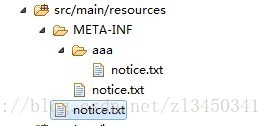Spring ResourceLoader.getResource() getResources()的理解
关于Spring Resource的资源类型以及继承体系我们已经在上一篇文件粗略的说了一下。Spring加载Resource文件是通过ResourceLoader来进行的,那么我们就先来看看ResourceLoader的继承体系,让我们对这个模块有一个比较系统的认知。
上图仅右边的继承体系,仅画至AbstractApplicationContext,由于ApplicationContext的继承体系,我们已经在前面章节给出,所以为了避免不必要的复杂性,本章继承体系就不引入ApplicationContext。
我们还是来关注本章的重点————classpath 与 classpath*以及通配符是怎么处理的
首先,我们来看下ResourceLoader的源码
public interface ResourceLoader {/** Pseudo URL prefix for loading from the class path: "classpath:" */String CLASSPATH_URL_PREFIX = ResourceUtils.CLASSPATH_URL_PREFIX;Resource getResource(String location);ClassLoader getClassLoader();}我们发现,其实ResourceLoader接口只提供了classpath前缀的支持。而classpath*的前缀支持是在它的子接口ResourcePatternResolver中。
public interface ResourcePatternResolver extends ResourceLoader {/*** Pseudo URL prefix for all matching resources from the class path: "classpath*:"* This differs from ResourceLoader's classpath URL prefix in that it* retrieves all matching resources for a given name (e.g. "/beans.xml"),* for example in the root of all deployed JAR files.* @see org.springframework.core.io.ResourceLoader#CLASSPATH_URL_PREFIX*/String CLASSPATH_ALL_URL_PREFIX = "classpath*:";Resource[] getResources(String locationPattern) throws IOException;}通过2个接口的源码对比,我们发现ResourceLoader提供 classpath下单资源文件的载入,而 ResourcePatternResolver提供了多资源文件的载入。
ResourcePatternResolver有一个实现类:PathMatchingResourcePatternResolver,那我们直奔主题,查看PathMatchingResourcePatternResolver的getResources()
public Resource[] getResources(String locationPattern) throws IOException {Assert.notNull(locationPattern, "Location pattern must not be null");//是否以classpath*开头if (locationPattern.startsWith(CLASSPATH_ALL_URL_PREFIX)) {//是否包含?或者*if (getPathMatcher().isPattern(locationPattern.substring(CLASSPATH_ALL_URL_PREFIX.length()))) {// a class path resource patternreturn findPathMatchingResources(locationPattern);}else {// all class path resources with the given namereturn findAllClassPathResources(locationPattern.substring(CLASSPATH_ALL_URL_PREFIX.length()));}}else {// Only look for a pattern after a prefix here// (to not get fooled by a pattern symbol in a strange prefix).int prefixEnd = locationPattern.indexOf(":") + 1;//是否包含?或者*if (getPathMatcher().isPattern(locationPattern.substring(prefixEnd))) {// a file patternreturn findPathMatchingResources(locationPattern);}else {// a single resource with the given namereturn new Resource[] {getResourceLoader().getResource(locationPattern)};}}}由此我们可以看出在加载配置文件时,以是否是以classpath*开头分为2大类处理场景,每大类在又根据路径中是否包括通配符分为2小类进行处理,
处理的流程图如下:
从上图看,整个加载资源的场景有三条处理流程
- 以classpath*开头,但路径不包含通配符的
让我们来看看findAllClassPathResources是怎么处理的
protected Resource[] findAllClassPathResources(String location) throws IOException {String path = location;if (path.startsWith("/")) {path = path.substring(1);}Enumeration<URL> resourceUrls = getClassLoader().getResources(path);Set<Resource> result = new LinkedHashSet<Resource>(16);while (resourceUrls.hasMoreElements()) {URL url = resourceUrls.nextElement();result.add(convertClassLoaderURL(url));}return result.toArray(new Resource[result.size()]);}我们可以看到,最关键的一句代码是:Enumeration<URL> resourceUrls = getClassLoader().getResources(path);
public ClassLoader getClassLoader() {return getResourceLoader().getClassLoader();}public ResourceLoader getResourceLoader() {return this.resourceLoader;}//默认情况下
public PathMatchingResourcePatternResolver() {this.resourceLoader = new DefaultResourceLoader();} public Enumeration<URL> getResources(String name) throws IOException {Enumeration[] tmp = new Enumeration[2];if (parent != null) {tmp[0] = parent.getResources(name);} else {tmp[0] = getBootstrapResources(name);}tmp[1] = findResources(name);return new CompoundEnumeration(tmp);}- 不以classpath*开头,且路径不包含通配符的
处理逻辑如下
return new Resource[] {getResourceLoader().getResource(locationPattern)}; public Resource getResource(String location) {Assert.notNull(location, "Location must not be null");if (location.startsWith(CLASSPATH_URL_PREFIX)) {return new ClassPathResource(location.substring(CLASSPATH_URL_PREFIX.length()), getClassLoader());}else {try {// Try to parse the location as a URL...URL url = new URL(location);return new UrlResource(url);}catch (MalformedURLException ex) {// No URL -> resolve as resource path.return getResourceByPath(location);}}}其实很简单,如果以classpath开头,则创建为一个ClassPathResource,否则则试图以URL的方式加载资源,创建一个UrlResource.
- 路径包含通配符的
这种情况是最复杂的,涉及到层层递归,那我把加了注释的代码发出来大家看一下,其实主要的思想就是
1.先获取目录,加载目录里面的所有资源
2.在所有资源里面进行查找匹配,找出我们需要的资源
protected Resource[] findPathMatchingResources(String locationPattern) throws IOException {//拿到能确定的目录,即拿到不包括通配符的能确定的路径 比如classpath*:/aaa/bbb/spring-*.xml 则返回classpath*:/aaa/bbb/ //如果是classpath*:/aaa/*/spring-*.xml,则返回 classpath*:/aaa/String rootDirPath = determineRootDir(locationPattern);//得到spring-*.xmlString subPattern = locationPattern.substring(rootDirPath.length());//递归加载所有的根目录资源,要注意的是递归的时候又得考虑classpath,与classpath*的情况,而且还得考虑根路径中是否又包含通配符,参考上面那张流程图Resource[] rootDirResources = getResources(rootDirPath);Set<Resource> result = new LinkedHashSet<Resource>(16);//将根目录所有资源中所有匹配我们需要的资源(如spring-*)加载result中for (Resource rootDirResource : rootDirResources) {rootDirResource = resolveRootDirResource(rootDirResource);if (isJarResource(rootDirResource)) {result.addAll(doFindPathMatchingJarResources(rootDirResource, subPattern));}else if (rootDirResource.getURL().getProtocol().startsWith(ResourceUtils.URL_PROTOCOL_VFS)) {result.addAll(VfsResourceMatchingDelegate.findMatchingResources(rootDirResource, subPattern, getPathMatcher()));}else {result.addAll(doFindPathMatchingFileResources(rootDirResource, subPattern));}}if (logger.isDebugEnabled()) {logger.debug("Resolved location pattern [" + locationPattern + "] to resources " + result);}return result.toArray(new Resource[result.size()]);}值得注解一下的是determineRootDir()方法的作用,是确定根目录,这个根目录必须是一个能确定的路径,不会包含通配符。如果classpath*:aa/bb*/spring-*.xml,得到的将是classpath*:aa/ 可以看下他的源码
protected String determineRootDir(String location) {int prefixEnd = location.indexOf(":") + 1;int rootDirEnd = location.length();while (rootDirEnd > prefixEnd && getPathMatcher().isPattern(location.substring(prefixEnd, rootDirEnd))) {rootDirEnd = location.lastIndexOf('/', rootDirEnd - 2) + 1;}if (rootDirEnd == 0) {rootDirEnd = prefixEnd;}return location.substring(0, rootDirEnd);}分析到这,结合测试我们可以总结一下:
1.无论是classpath还是classpath*都可以加载整个classpath下(包括jar包里面)的资源文件。
2.classpath只会返回第一个匹配的资源,查找路径是优先在项目中存在资源文件,再查找jar包。
3.文件名字包含通配符资源(如果spring-*.xml,spring*.xml), 如果根目录为"", classpath加载不到任何资源, 而classpath*则可以加载到classpath中 可以匹配的目录中的资源,但是不能加载到jar包中的资源
第1,2点比较好表理解,大家可以自行测试,第三点表述有点绕,举个例,现在有资源文件结构如下:

classpath:notice*.txt 加载不到资源
classpath*:notice*.txt 加载到resource根目录下notice.txt
classpath:META-INF/notice*.txt 加载到META-INF下的一个资源(classpath是加载到匹配的第一个资源,就算删除classpath下的notice.txt,他仍然可以 加载jar包中的notice.txt)
classpath:META-*/notice*.txt 加载不到任何资源
classpath*:META-INF/notice*.txt 加载到classpath以及所有jar包中META-INF目录下以notice开头的txt文件
classpath*:META-*/notice*.txt 只能加载到classpath下 META-INF目录的notice.txt


